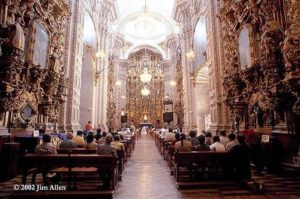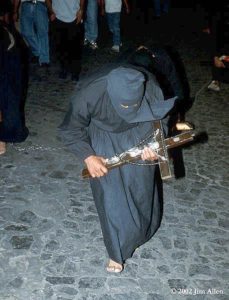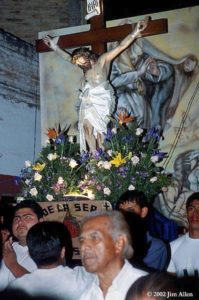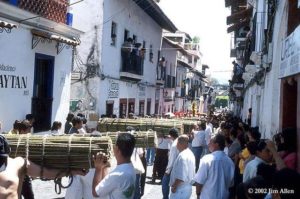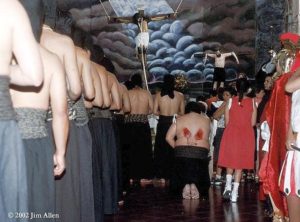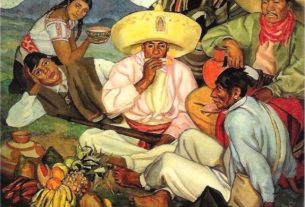The City of Silver
If you have heard of the picturesque, old colonial Mexican town of Taxco at all, you probably associate it with that precious metal so characteristic of Mexico – silver. If you had asked Cortés about Taxco almost 500 years ago, he would have made the same association. In fact, the silver and other minerals from the mines around Taxco are the reason why Cortés founded the town in 1529. The miners who followed extracted the silver from the hills to provide the raw material for the town’s artisans to design and produce the superb jewelry and other silver crafts for which the town is known. Today, you will find these works in the hundreds of shops selling silver throughout Taxco.
Taxco, and its 150,000 residents, snuggle up to the side of a mountain at almost 6,000 feet above sea level. The town is a very pleasant three hour drive or bus ride southwest of Mexico City. As you approach this town on the winding highway, you see it spilling down the side of one mountain and climbing up the side of another, all overseen by a new statue of Christ with outstretched arms. You start to understand why it has been declared a national historical monument. You know it is a town that you cannot pass by without further exploration.
To reach the heart of the city, you take one of the narrow, winding cobblestone streets to the active main zócalo or town square, the Plaza Borda. The plaza has the feeling of tilting to one side because of its massive baroque church, the Templo de Santa Prisca, heavily decorated, inside and out. The church was built between 1751 and 1758 by the plaza’s namesake, José de la Borda, with wealth generated from Taxco silver. Building this shrine almost broke Borda, who felt that was just fine since his philosophy was, “God gives to Borda, so Borda gives to God.”
One week out of the year, Borda’s beloved Santa Prisca becomes the focus of Taxco’s own unique celebration of the suffering, death, and resurrection of Christ – Easter Holy Week or Semana Santa. During this week, Taxco’s silver takes a second place to the saints processing from the churches and the sinners showing their penitence through self-inflicted suffering.
The Triumphant Entry
You start to feel the anticipation for the week on the Saturday before Palm Sunday as palm vendors, most from the small, outlying village of Tlamacazapa, stake out every available space around the Santa Prisca, weaving palm leaves into complicated designs often representing Christ on the cross and sometimes decorated with delicate, colorful blossoms. A few pesos will buy you an intricate palm weaving – the wonderful smiles are free!
On Palm Sunday, the excitement continues to build as you have one last chance to buy your palm weavings before Christ’s triumphant entry into the city. The wooden carving of Christ on a donkey leaves at dawn from the outlying village of Tehuilotepec, almost 4 miles from Taxco, to march to Taxco for the grand entry.
The first sign that the procession is entering the city is a flood of kids on bicycles, each with a palm attached to the front, screeching their brakes on the hilly streets of Taxco. You hear the drums of the procession at about the same time that the twelve Apostles, dressed in their colorful tunics and headdresses and walking barefoot, crest the hill. Then you spot the Christ figure, decorated with colorful flowers and palms arched over the top, followed by a huge crowd of people holding their palm weavings high to be blessed by the priests. This colorful and joyful procession to Santa Prisca is only a prelude of the many to come, each becoming more solemn, leading up to the crucifixion of Christ.
Virgins in the Streets
The processions are a feast for all of your senses. Many of the processions during the week, which start in the evenings, are led by cute, young children dressed as angels, complete with halo and wings, and carrying candles. If you are at the start of the procession, these little angels will be walking. Later in the evening they will be sleeping in their parent’s arms, and the halo may be a bit tilted.
There are girls dressed all in white, with white veils, walking barefoot and swinging incense burners, the incensarios, which spread the potent white smoke of the copal incense amongst the crowd, purifying the air for the impending procession. Often there is a young boy dressed as an angel, determinedly swinging a large bell to announce the approach of the spectacle.
In most of Mexico, the townspeople play the parts of the major Holy Week characters such as Jesus and the Virgin Mary. Taxco is unique in using the wooden sculptures from the churches of the town and surrounding villages to represent these holy figures. These religious icons are carried on wooden litters, shouldered and attended by the devotees from the churches, who often walk barefoot. For the nighttime processions, many of the statues are fixed with battery or generator driven lights that cast eerie shadows over the features of the carvings. Some statues are small, precious carvings that are carried easily by two people. Some are enormous figures carried on heavy wooden platforms that require eight people to carry and a support team to move overhead wires and support the front of the litter as they walk down the precipitous cobblestone streets.
With all of the visual stimulation, you have to close your eyes to hear the haunting sounds of the accompanying drums, flutes, horns and violins with their rhythmic melodies – sounds that date from prehispanic times. To add to the mystery, underneath some of the mobile statues chains are shuffled rhythmically up and down and across the cobblestones by crouching devotees.
Suffering in the Streets
Then there are the penitent ones or penitentes – the men and women who show their faith and penitence by inflicting pain on themselves during this most holy week – an ancient tradition dating to the middle ages and introduced to Mexico from Spain almost 500 years ago. Since the prehispanic people were already accustomed to Aztec blood rituals and sacrifices, sacrifices to the new Spanish deities fit in nicely. At times the sacred and secular authorities have decided that it was not a good idea to continue this tradition, but it has always reemerged, often changed, but still intact.
Today, most Mexican towns, as well as those in Spain, have significantly toned down the level of self-inflicted suffering, at least as seen by the outsider. The people of Taxco made a very different decision. They embraced it and have adapted it in some very unique ways, making Semana Santa in Taxco like none other in the world.
Not all penitentes suffer equally. The faithful who carry the carved statues are penitentes , as are the women dressed in white who walk barefoot alongside the procession carrying candles. Although hauling statues on heavy wooden litters on steep slippery cobblestone streets while barefoot is not to be taken lightly, the penitentes who belong to the sacred brotherhoods have a much harder week.
To be in a brotherhood of penitentes and to participate in the procession is not a decision these men and women undertake quickly or lightly. They prepare years in advance and involve friends and family as support. During the year before they participate, the penitente must take part in prescribed spiritual acts. Why do they do this? The answers to that question are probably equal to the number of penitentes , but is purportedly a product of their profound faith. The declared objective is to atone for one’s faults and to request health and well being for the penitente and for the community.
The three Brotherhoods are: the Animas or the Bent Ones, the Encruzados, and the Flagelantes. Their names give you a pretty good clue as to their rituals.
All penitentes wear a long black dress cinched at the waist with a horsehair belt. They walk the procession route barefooted with their head covered with a black fabric hood with only eyeholes. The penitente is never seen in public without the hood. This is a private penitence, no one needs to know who is behind the eyes.
The dress and anonymity, with only the hint of eyes behind the mask, gives these men and women a mystery and a timelessness. They are transformed from the people of everyday life into a representation. You could just as well be watching a procession of hundreds of years ago.
The Spirits of Taxco
You may hear and sense the Animas or spirits before your mind really registers their presence. You hear the sound of the chains, attached to their ankles, as they are dragged over the ancient cobblestone street. Since they walk bent over, almost ninety degrees, at the waist, you do not even have a glimpse of their eyes behind the mask to remind you that they are, in fact, humans. To complete their burden, in their hands they clutch either sacred relics, such as crosses, or carry large lighted candles.
Because of their stance these Animas are also referred to as “the bent ones.” In fact, they are only supposed to rest by going down on hands and knees while the procession is stopped. This is the only brotherhood that will admit women, who drag individual chains in the procession. By contrast, the men are chained together in groups of about 20 with a much heavier chain. Because of their stance and their hoods, the only way these penitentes know where to go is by watching the hands of their attendants. These attendants also help to prevent them from tripping on the chains that tumble ahead of the penitentes on the steep slopes. Although at first glance you may not feel this is a very difficult penitence, try it yourself for a block or two, and you will start to get a feel for what it would be like to do it for over two miles on steep streets.
Thorns in His Shoulder
The two remaining brotherhoods have accepted an even more severe penance.
The Encruzados are not nailed to a cross, but it is almost as if the cross is nailed to them. They walk the long processions burdened with a bundle of thorn-encrusted blackberry canes lashed to their bare back and outstretched arms. The penitente chooses how much he wants to suffer, so he decides how many canes to put in his bundle. A typical bundle would be about a foot in diameter and would weigh over 100 pounds. As you watch the penitente’s body respond when the bundle is positioned on his back, you may wonder if he fully understands, until that moment, how cruel his punishment is to be.
The bundle is positioned so that the penitente’s arms are wrapped over the cane and he carries a lighted candle in each hand. Given the weight and positioning, the penitente must walk with his shoulders and neck in an awkward bent position. To add to the suffering, since he is shirtless, the horsehair belt burns into his skin. The Encruzado must remain in this position, with the thorns digging into his flesh, for the hours of the procession, relieved only briefly by his attendants who remove some of the weight by lifting the bundle of canes during the many long periods when the procession does not move.
Self-Flagellation
Finally, there are the Flagelantes, who are the hardest to watch. These men walk the procession bare-backed and carry a large wooden cross, which can weigh over 100 pounds, in the crook of their arms. In his hands, each carries a rosary and a whip with metal points affixed to the end. At prescribed times or places, he gives his cross to his attendants before he falls to his knees. He brings the whip forward then swings it back so that the metal points of the whip eat into his back. He alternates, first one side of his back, then the other to create two bloody raw areas. As the week progresses, these bloody wounds are reopened every night in what must be an agonizing progression. It is not uncommon to see Encruzados who have the raw backs of the Flagelantes, so obviously some of these men do double duty!
Although you may find these practices beyond your own comprehension, remember that these men and women have made a conscious, carefully thought-out decision. They are also strongly supported by their families and friends during the week. If it becomes too painful for a penitente, he is quietly taken out of the procession into a safe house along the way.
The Quiet of the Garden
All of these processions lead up to Thursday and the wonderful reenactment of the Garden of Gethsemane in the front courtyard of Santa Prisca. Early in the morning, the men are at work enclosing the courtyard with laurel branches to transform it into a cool, calm shelter. A little later the women of the town bring flowers and birds in cages to complete the garden atmosphere, before a statue of Christ is brought out from the church and placed in the position of honor. Throughout the day, the people come to visit Christ and spend some time in this wonderful garden creation.
The Capture and Crucifixion
In the afternoon, this calm is broken as men dressed as Roman soldiers and referred to as “the Jews” move through the streets searching for Jesus. The proclamation is issued that Jesus is guilty and must die. The hated Judas also appears in the streets with his greasy hair and sickly grin, dressed in a bright yellow robe. He darts in and out of the crowd, all the time clinking together his ill-gotten gain of “30 pieces of silver” for betraying Christ. Once again, that precious metal, silver, plays a part in the story.
Then, Christ is captured! A statue of Christ, blindfolded with hands tied behind his back, is moved to a church “jail” where it is “imprisoned.” Throughout the night he is watched over by the Jews and the penitentes , who mark their presence by the continual rattling of chains. Late in the night, there is the marvelous, somber procession of the Christs, where over 40 representations of Christ on the cross are processed through the streets, accompanied by that haunting, rhythmic music, in an event that lasts into the next morning.
Friday is another day of continuous activity and high tension, as we know that Christ will be mercilessly crucified on the cross! As Christ is moved from his jail to be taken to the cross, there is the procession of the “three falls.” This scene is enacted in front of Santa Prisca, complete with a mass, where the falls are shown by a dipping of the Christ statue. Statues of the Virgin also come out to witness this event and express their sorrow. Then Christ moves into the church where he will be crucified.
This is the most sorrowful of times and the penitentes are approaching their peak. During the “crucifixion” the penitentes move inside the church. It is one thing to see the self-flagellation on the streets – and quite another to see it in the church!
The crucifixion is followed by the very solemn procession of the “sacred interment” where the representations of the crucified Christ are carried through the streets accompanied by all of the penitentes who are now very actively fulfilling their vows to suffer. The day is completed when, at midnight, begins the silent procession with hundreds carrying candles walking through the streets. From a distance this looks like a river of flickering candles flowing through the crooked streets of this mountainous town.
The Resurrection & Recovery
Saturday is hauntingly quiet as people await the resurrection. The mass of the resurrection occurs late in the evening at Santa Prisca. The church is overflowing with people, but the most interesting activity occurs in the little plaza in front of the church. This is where the Jews – the Roman soldiers – receive word that Christ is risen and promptly fall to the ground en masse, now true believers.
In the United States, Sunday is the Easter day. For Taxco it is a day of recovery from the intense week where we have witnessed life, death, and now the rebirth. Some joyfully singing youths walk through the streets accompanied by their Savior Shepherd, but most people are preoccupied with a return to normalcy.
Taxco, once again, returns to being the town where you can buy wonderful silver crafts, a place that is calm and picturesque. A place where sins take place behind closed doors and the saints reside in the churches. The sacrifices have been offered and the rebirth is complete. All is good!

